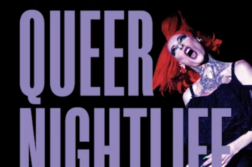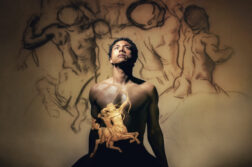 Celibacies: American Modernism and Sexual Life
Celibacies: American Modernism and Sexual Life
by Benjamin Kahan
Duke University Press. 232 pages, $23.95
Most of us have negative associations with the word celibacy. Catholics think of priests, whose vows of celibacy have been tarnished by the pedophilia scandal. Growing up, we all encountered “old maids” or “bachelor uncles,” who were presumed celibate and pitied by adults. For gays and lesbians, celibacy implies the closet, historically the place where those unable to accept their sexual nature lived lives of lonely isolation. This scholarly but accessible study turns our notions of celibacy on their heads. Kahan demonstrates that, starting in the U.S. in the 1840’s, celibacy became a source of power, especially for women, to reform public life. By the early 20th century, celibacy provided a way for people to subvert repressive social, economic, racial, and political systems. Before women’s and gay liberation made celibacy unfashionable, it had acquired, in the hands of a figure like Andy Warhol, the status of a sexual identity. Warhol’s famous Factory was an instance of “secular group celibacy.” What celibacy decidedly is not, Kahan insists, is synonymous with repression or closeted homosexuality. Kahan approaches his subject by analyzing the work of writers—Henry James, Marianne Moore, W.H. Auden—and a curious figure from the Harlem Renaissance, Father Divine, whose followers, black and white, lived in cooperative households where celibacy was practiced. The book’s power derives from Kahan’s skill in making us reconceive sexual categories, particularly celibacy, which he argues convincingly is a positive way of choosing how to be in the world.
Daniel A. Burr
 Growing Up Golem
Growing Up Golem
by Donna Minkowitz
Magnus Books. 216 pages, $19.99
Donna Minkowitz, lesbian activist and investigative journalist, started writing for the Village Voice back in the 1980’s, right after graduating from Yale. For thirteen years or so, she wrote about “sexual abuse, rape, baby- and wife-beating … but mostly about being queer.” While she was growing up, her family lived on the fringes of poverty, moving every year. Her brilliant mother had a doctorate in philosophy but never rose above adjunct level; her father bounced from one low-paying, menial job to another. Of their three children, it was Donna who, as a child, was beaten by her father. As an adult, she wondered if he got sexual satisfaction from hitting her. But all three girls—especially Donna—were on the receiving end of their mother’s seductive ways of talking and acting. Minkowitz goes into detail about the (verbal) sexual boundaries that her mother exceeded. It is no wonder that she wrote “I wasn’t a real person” but instead a golem—“an artificial creature created by magic, often to serve its creator” (as defined by the Jewish Virtual Library). Descended from Eastern European Jewish mystics and feeling close to her roots, Minkowitz understandably chose this being to identify with. Stricken in her mid-thirties with a disabling case of repetitive stress injury, she was reduced to dictating into primitive voice recognition software, then making multiple corrections. Everything that involved her arms and hands, from taking a book off the shelf to having sex, caused agonies of pain. Surmounting this impediment, Minkowitz is an engaging and amusing storyteller. She’s at her comic best when describing her girlfriends and the “lesbian therapy Mafia” in which she found herself entangled. While the golem trope occasionally wears a little thin, this is a thoughtful memoir by one of our community’s stalwarts.
Martha E. Stone
 With: New Gay Fiction
With: New Gay Fiction
Edited by Jameson Currier
Chelsea Stations Editions. 278 pages, $20.
The characters in this anthology of short stories by gay authors run the gamut from husbands and fathers to tricks, hustlers, and boyfriends. As with most anthologies, this one is a mixed bag. There are stories set in New Orleans, San Francisco, and New York, and there’s even a piece of historical fiction set during the Civil War. David Bergman’s “A Sentimental Education” is a nicely terse, contemporary riff on Flaubert’s novel of the same name. Similarly, “The Beautiful Boy,” by Shaun Levin, is a kind of gloss on Andrew Holleran’s Dancer From the Dance, nicely controlled and lyrical throughout. David Pratt’s “What is Real” cleverly uses a series of antithetical statements to make a heartfelt point about the illusions that come into play when the narrator is picked up by another man along a roadside one day: “He did not say, ‘How far did you walk?’ I did not say, ‘Five miles, at least.’ … I did not feel bathed in grace for the first time in my twenty years, nor did I feel at last welcomed into a warm, bright room outside of which I’d long waited.” Most of the stories in With are written well; some are overly earnest; and one, “Follow Me Through,” seems morally indefensible (a man kidnaps a child to compensate for the loss of his lover to AIDS).
Dale Boyer
 Fault Tree
Fault Tree
by Kathryn L. Pringle
Omnidawn. 80 pages, $15.95
Selected by renowned poet C.D. Wright for Omnidawn’s First/Second Book Prize, Kathryn L. Pringle’s second poetry collection, Fault Tree, begins with epigraphs about Einstein’s theories and Boolean logic. However, it quickly becomes clear that no physical or emotional reality is certain or stable in the world of these poems. How does one live in an exploded moment? Fault Tree answers this question in fragments that somehow cohere. The cohesion is partly effected by the ghost of a narrative: A soldier at war is harmed and does harm. A distressed soul takes medications. Some comfort is found in bed. Some panic begins in a Chinese restaurant. But if narration depends on time, this story is out of time; moreover, the narrator is dead. The solitary voice that remains conveys an authority, poise, and wit that make sense out of insanity—a confounding soldier-maniac’s voice that is ironically strong, centered, and charming. The tone grounds a work of mind-blown world devastation. Everything is obliterated and isolated: “all is war / we haven’t not had one.” I recommend reading this memorable and strangely moving book-length poem from beginning to end. Dipping into it could be disorienting, especially if you’re not accustomed to conceptual poetry, a genre in which Pringle is clearly a rising star.
Mary Meriam





